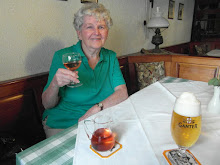The Gasthof Engel in Doerlinbach at right
The perfect Pils!
The Engel is a family-run Gasthaus where we know the entire family: Martin, the chef; Uli, his brother, who looks after the Gasthaus; their mother, Frau Grimm, who ran it with their father for many years; Martin's wife, Monika, who works in the kitchen with Frau Grimm, who still helps, and Martin and Monika's four children.
You'll note that the lettering on the Engel says "Gasthof Engel Pension" while the sign below, which stands outside the Gasthaus, calls it "Gasthaus Engel." The sign is fairly new. The word "Engel" means angel.
Uli serving our table. He is proud of his Pils! We were a group of six.
Martin and I and one of his famous steaks! That's for another story.
The picture shows a view of the town and the crowd below the church in Doerlinbach.
 Rosenmontag is always the biggest day of Fastnacht, with parades in many towns and cities, including a large one in Freiburg, 30 minutes south of us. On that day, stores and businesses close between noon hour and about 2 p.m. Our bank closes for the entire day. In northern Germany, the parades in Mainz, Koeln (Cologne) and Duesseldorf are shown on national TV. They are colourful, with thousands of onlookers and thousands in the parades as well. Candy and chocolates are thrown out to the crowds, and Schnaps is offered from the floats in the parade to adults lining the streets (another good reason to go to the parades!).
Rosenmontag is always the biggest day of Fastnacht, with parades in many towns and cities, including a large one in Freiburg, 30 minutes south of us. On that day, stores and businesses close between noon hour and about 2 p.m. Our bank closes for the entire day. In northern Germany, the parades in Mainz, Koeln (Cologne) and Duesseldorf are shown on national TV. They are colourful, with thousands of onlookers and thousands in the parades as well. Candy and chocolates are thrown out to the crowds, and Schnaps is offered from the floats in the parade to adults lining the streets (another good reason to go to the parades!). Fasching or Karneval up north dates back to the 1700s and 1800s. Here in the south, Fastnacht dates back to the Middle Ages. Thousands of wrapped candies are tossed to the children in our area.
No pancakes here for Shrove Tuesday as in North America or Great Britain. Instead, it is more parades and the "burning of the witch" in some towns. That supposedly gets rid of the evil spirits before Lent. A huge bonfire of branches is lit, with a "witch" facsimile being thrown in. Hard to imagine what it was like back in the 1700s and 1800s when that happened to real people in various countries. Afterwards, everyone heads to the Gasthauses for one final night of revelry.
Aschermittwoch or Ash Wednesday officially ends Fastnacht and begins Lent. The streets are quiet on that Wednesday, with many nursing their heads I have no doubt and also tired out from all the late nights.
Our group of German and Canadian friends traditionally meet for lunch at the Krone in Allmannsweier on Ash Wednesday, with traditional German Lenten dishes served that day. Ellie, who runs the Gasthaus with her husband, Peter, is also the cook. She offered pickled herring in a sour cream sauce and Bohnensuppe (bean soup), both typical dishes at the end of Fastnacht. She also offered Bockwurst (a big fat sausage that looks like a chubby wiener).
Shown below, Ellie serving some of our group. Even though she was suffering from a painful toothache, she maintained her usual friendly and pleasant manner and managed to prepare our food as well as ever.
A few other dishes are also traditional, such as Matjes--herring fillets from immature herring. They are very slightly pickled and salted (almost raw). They are one of Holland's favourite national fast food snacks. They can also be bought in Germany, but they are not as popular as the regular pickled herring.
Brathering (fried herring), minus heads, are fried in a batter and then pickled and preserved. These come in shallow tins in Germany and are available everywhere.
Another favourite is Rollmops, where a cucumber pickel is placed inside a pickled herring fillet, rolled up and held together with toothpicks.
In the old town of Lunenburg in Nova Scotia, settled by Germans in the mid 1700s, herring pieces in a jar with slices of onion, vinegar, pickling spice and a little sugar is known as Solomon Gundy. This is available in supermarkets in Nova Scotia.
Below, a plate with pickled herring in a sour cream sauce and accompaniments
On this past Ash Wednesday, the pickled herring in a sour cream sauce was served with boiled potatoes (Hans says to buy the best you can find, such as Yukon Gold), sliced, raw onions, apple slices and a dill pickle. The sauce, of course, is important as is using sour cream for it. Most of our friends ordered this, including Hans, who said it was one of the best he's had. The reason for eating pickled herring, it is said, is that the salt and vinegar restore the electrolyte salts from over-indulgence the night or nights before!
Below, a bowl of Bohnensuppe (bean soup) with a wiener on top.
Several ordered the Bohnensuppe, which is served everywhere during Fastnacht and Lent. It should be hot and well spiced. It can also include peas and lentils. The classic is made from fresh vegetables, kidney beans, Speck (pieces of ham) and a beef or vegetable broth. It is served with a wiener on top of the soup (or sometimes a Bockwurst instead of a wiener). Fresh hearty bread is served alongside it.
I had neither of the above dishes. Three of us had the Bockwurst, served with potato salad and Feldsalat. It, too, was excellent. See it below.
Ellie taking another order.




































